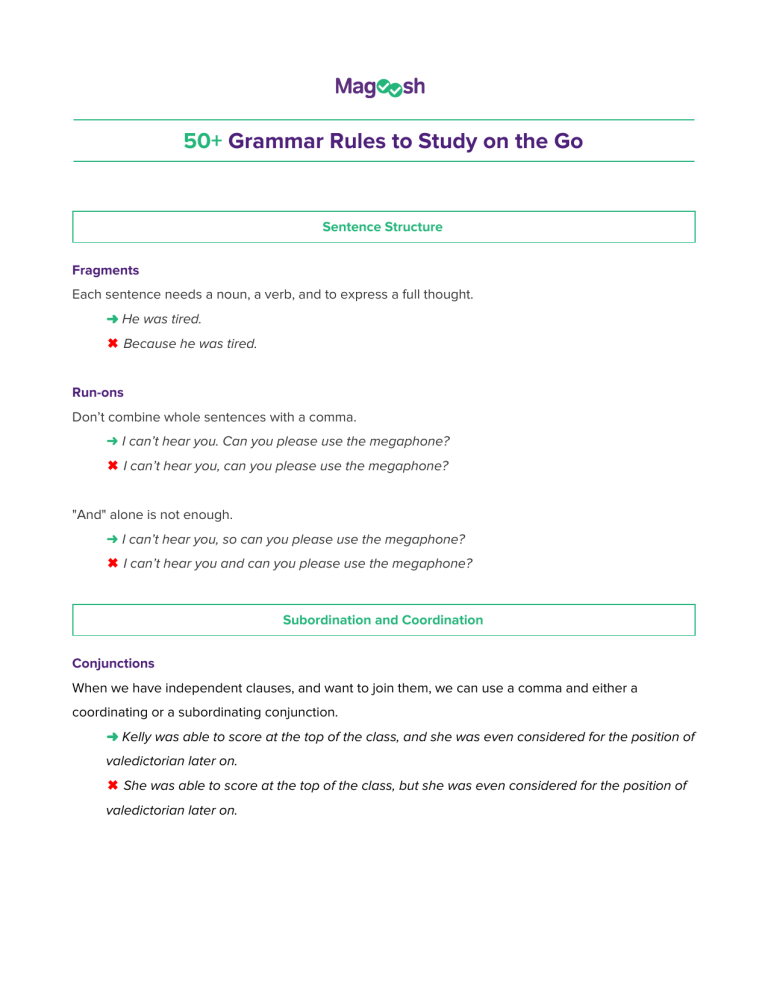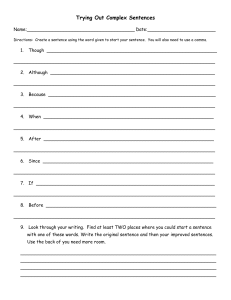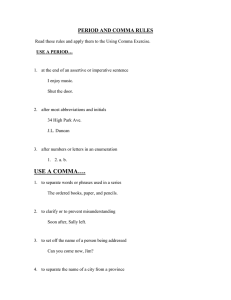
50+ Grammar Rules to Study on the Go Sentence Structure Fragments Each sentence needs a noun, a verb, and to express a full thought. ➜ He was tired. ✖ Because he was tired. Run-ons Don’t combine whole sentences with a comma. ➜ I can’t hear you. Can you please use the megaphone? ✖ I can’t hear you, can you please use the megaphone? "And" alone is not enough. ➜ I can’t hear you, so can you please use the megaphone? ✖ I can’t hear you and can you please use the megaphone? Subordination and Coordination Conjunctions When we have independent clauses, and want to join them, we can use a comma and either a coordinating or a subordinating conjunction. ➜ Kelly was able to score at the top of the class, and she was even considered for the position of valedictorian later on. ✖ She was able to score at the top of the class, but she was even considered for the position of valedictorian later on. Parallel Structure Creating Parallel Structure Whether it is with nouns, adjectives, verbs, or adverbs, you need to make sure the form is consistent. ➜ The girls at the sleepover said they wanted ice cream. ✖ The girls at the sleepover said she wanted ice cream. Remember that if you cannot physically count a noun, use the words “less,” “much,” and “amount.” ➜ I had less strength after running the marathon. ✖ I had fewer strength after running the marathon. Remember that if you can physically count a noun, use the words “fewer,” “many,” and “number.” ➜ I had fewer apples than I thought because my dad ate some. ✖ I had less apples than I thought because my dad ate some. Modifier Placement Misplaced Modifiers Misplaced modifiers don’t modify the correct part of the sentence. ➜ Sonia was eagerly waiting for her book to come in the mail. ✖ Sonia was waiting for her book to come in the mail eagerly. Dangling modifiers don’t actually modify anything in the sentence. ➜ Typing furiously, she finished her essay. ✖ Typing furiously, the essay was finished. Squinting modifiers logically make sense as modifiers for two subjects in the same sentence. ➜ Students who don’t practice often for the SAT score lower than they would like. ✖ Students who don’t practice for the SAT often score lower than they would like. When encountering a modifier problem, first identify the incorrectly-placed modifier. Having played composers such as Beethoven and Mozart at a very young age, Alicia Keys’ songs have many elements of classical music. sat.magoosh.com 2 ➜ Having played composers such as Beethoven and Mozart at a very young age ✖ Alicia Keys’ songs have many elements of classical music. Change a modifier problem in one of two ways: figure out either where to place the modifier, or how to correct the subject. ➜ Having played composers such as Beethoven and Mozart at a very young age, Alicia Keys has many elements of classical music in her songs. ✖ Having played composers such as Beethoven and Mozart at a very young age, Alicia Keys’ songs have many elements of classical music. Adverb Placement Determine if there are any words modifying a verb or adverb, and verify that they are also adverbs. ➜ Mary yelled to Tina, “Drive safely – it’s wet out there.” ✖ Mary yelled to Tina, “Drive safe – it’s wet out there.” Verbs Verb Tenses If there’s a sequence of events, make sure their tenses put them in the right logical order. ➜ Ernest Hemingway’s short stories, including the favorite “Indian Camp,” continue to be highly influential pieces of fiction despite the fact that they were written over fifty years ago. ✖ Ernest Hemingway’s short stories, including the favorite “Indian Camp,” continue to be highly influential pieces of fiction despite the fact that they have been written over fifty years ago. Has/Have + Participle = describes an action or event that happened in the past, and continues in the present. ➜ Since I moved to California, I have walked Bucky in the mornings. ✖ Since I moved to California, I walked Bucky in the mornings. Had + Participle = describes an action or event in the past that happened before another action in the past. ➜ Before I moved to California, I had walked Bucky in the mornings, not at nights. ✖ Before I moved to California, I walked Bucky in the mornings, not at nights. sat.magoosh.com 3 Whenever we use the past perfect, we must also have another verb in the sentence that is in the simple past. ➜ Before I m oved to California, I had walked Bucky in the mornings, not at nights. ✖ Before I moved to California, I walked Bucky in the mornings, not at nights. Command words, or words such as “request that,” “order that,” and “require that” are followed by “be + verb participle.” ➜ He requested that she be present at the meeting. ✖ He requested that she was at the meeting. The subjunctive mood implies conditionality—in other words, a hypothetical or something that isn’t and can’t be reality. To show this, we change the verb “was” to “were.” ➜ Were she responsible for the break-in, she would not have an airtight alibi. ✖ Was she responsible for the break-in, she would not have an airtight alibi. Agreement The SAT likes to put extra information between the subject and verb. If you cross out everything between the subject and the verb, the correct choice will be much more obvious. ➜ The teachers, who loaded up their trays with pizza, cookies, and chocolate milk, stand at the back of the cafeteria. ✖ The teachers, who loaded up their trays with pizza, cookies, and chocolate milk, s tands at the back of the cafeteria. Pronouns A pronoun refers to a noun in the sentence. A pronoun can either take the subjective or objective form depending on its role in the sentence. ➜ To whom are you referring? ✖ To who are you referring? sat.magoosh.com 4 When you’re listing other people as well as yourself, “I” or “me” should come last. ➜ Between you and me, the SAT Writing Section is not too difficult once you know the common error types that appear in all three sub-sections of the writing portion. ✖ Between you and I, the SAT Writing Section is not too difficult once you know the common error types that appear in all three sub-sections of the writing portion. Possessive Determinants Its = possessive. It’s = it is. ➜ A marathon is a challenging race. It’s a combination of endurance, grit, and focus. ✖ A marathon is a challenging race. Its a combination of endurance, grit, and focus. ’s = singular possessive. s’ = plural possessive. ➜ The students' lockers are all in great order. ✖ The student's lockers are all in great order. BUT ➜ The student's locker is in great order. ✖ The students' locker is in great order. Frequently Confused Words Know that diction questions will appear, and always be on guard if you can’t seem to find a mistake in an Identifying the Error question. ➜ I didn't know what effects the experiment would have on the subjects. ✖ I didn't know what affects the experiment would have on the subjects. Logical Comparisons Note the word “than.” It almost always signals that we’re making a comparison, so you know to check for a problem there. ➜ Oranges’ skins are tougher than lemons’. ✖ Oranges’ skins are tougher than lemons. sat.magoosh.com 5 When making comparisons, find the nouns—where the problem might happen. ➜ To prepare for college admissions, I had to prepare for the SAT, the ACT, and the TOEFL. ✖ To prepare for college, I had to prepare for the SAT, the ACT, and take the TOEFL. Conventional Expression (including Prepositions) When it’s a preposition that’s underlined, it’s all about your ear. ➜ I don't know what time she signed o n. ✖ I don't know what time she signed upon. If you see an underlined preposition, find the words before and/or after that should get paired with it. ➜ Despite being wrong a good portion of the time, Mary nevertheless always insists o n having her own way. ✖ Despite being wrong a good portion of the time, Mary nevertheless always insists a t having her own way. Punctuation Commas Every comma should serve a purpose, so never place one without a reason. ➜ If you tend to get confused when using commas, keep in mind that every comma should serve a purpose, so never place one without a reason. ✖ If you tend to get confused, when using commas, keep in mind, that every comma should serve a purpose, so, never place one without a reason. Commas go between independent clauses, but only when paired with a coordinating conjunction (FANBOYS). ➜ The dog raced after the car, but he was left in the dust. ✖ The dog raced after the car but he was left in the dust. Commas go after dependent clauses, prepositional phrases, or other descriptive phrases at the beginning of sentences. ➜ On the other hand, the fortune teller had been correct. ✖ On the other hand the fortune teller had been correct. sat.magoosh.com 6 Commas surround non-essential phrases, such as appositives. ➜ Betsy, a lovely woman, offered to knit us socks. ✖ Betsy a lovely woman offered to knit us socks. Commas go between elements in a list. ➜ The child ate cotton candy, fried cookies, and ice cream at the fair. ✖ The child ate cotton candy fried cookies and ice cream at the fair. Commas go between two adjectives that describe the same noun AND are interchangeable. ➜ My nephew made me a funny, cute card. ✖ My nephew made me a funny cute card. Commas separate transitional words or phrases from the rest of the sentence. ➜ However, the judge disagreed. ✖ However the judge disagreed. Commas go before or after quotes. ➜ He asked, “Why?” “Because it just makes sense,” she replied. ✖ He asked “Why?” “Because it just makes sense” she replied. Commas are used when addressing a person by name. ➜ Peter, would you pass the pepper? ✖ Peter would you pass the pepper? Semicolons and Colons A semicolon is meant to separate two clauses that, by themselves, could function as sentences. ➜ That supermarket is my favorite; it carries all my favorite foods for reasonable prices. ✖ That supermarket is my favorite, it carries all my favorite foods for reasonable prices. If two sentences are talking about the same topic, a semicolon placed between them may improve the flow of ideas from one to the other. ➜ The platypus is a strange animal: it lays eggs and has a bill but is still considered a mammal. ✖ The platypus is a strange animal, it lays eggs and has a bill but is still considered a mammal. sat.magoosh.com 7 Colons can also appear between independent clauses, but should really only be used when the second clause clarifies, or paraphrases the first. ➜ We will need the following for our camping trip: a tent, sleeping bags, and hiking boots. ✖ We will need the following for our camping trip: a tent: sleeping bags: and hiking boots. Hyphens Hyphens appear not just within sentences, but within words themselves. Adjectives can be formed of two or more words connected by hyphens, but these adjectives may only appear before the noun they describe. ➜ The hand-made necklace was made of local turquoise. ✖ The hand made necklace was made of local-turquoise. Apostrophes Contractions use apostrophes to stand in for letters that have been removed. ➜ You shouldn’t poke the cat, so don’t do it. ✖ You shouldnt poke the cat, so dont do it. If a noun is singular or is plural but doesn't end with an s, add 's. If it is plural and ends with an s, just add an apostrophe. ➜ Our architect used the PTA members’ ideas in the design for the children’s playground. ✖ Our architect used the PTA member's ideas in the design for the childrens' playground. Be careful! Several contractions are homophones for possessive pronouns, which do NOT use apostrophes. For example, it's means it is, while its is a possessive pronoun. ➜ It's a little confusing. ✖ Its a little confusing. Parentheses and Dashes Parentheses surround non-essential elements within sentences. ➜ The road trip (which was all my brother’s idea) was ruined when the car broke down. ✖ The road trip which was all my brother’s idea was ruined when the car broke down. sat.magoosh.com 8 Like commas and parentheses, dashes set off non-essential elements in sentences. They can be used in pairs, to set off phrases in the middle of sentences, or alone, to set off phrases at the end of sentences. Dashes provide even more emphasis than parentheses, and they do a great job of catching readers' eyes and drawing attention to certain parts of a sentence. ➜ My friends — Megan, John, and Ricky — offered to help me move. ✖ My friends Megan John and Ricky offered to help me move. Quotation marks always appear in pairs and closing quotation marks must be placed outside a sentence's end-punctuation. ➜ “Four score and seven years ago,” began Lincoln. ✖ “Four score and seven years ago”, began Lincoln. If you see a comma or an “and” underlined in a writing multiple choice question (but not used together), ask yourself whether they can be replaced by a period. If they can, then there’s the problem. ➜ I went to the dog park, and then I went to the store. ✖ I went to the dog park, then I went to the store. Effective Language Use Watch out for synonyms in the same sentence. ➜ My family goes to the beach every year. ✖ Annually, my family goes to the beach every year. Style and Tone Sentences that are hard to understand = bad. ➜ Not many people dig through trash as much as I do. ✖ Not many people do as much digging through trash as I do. Voice You don’t want to say anything in a casual, lax way—or too formally, either. sat.magoosh.com 9 ➜ The SAT places harsh demands on a student’s attention, forcing them to be focused for almost four hours straight. ✖ The SAT is really hard because you have to keep your mind on the task for four straight hours. BUT ➜ Many people disagree with the theory. ✖ The theory has many people who disagree with it. Happy studying! sat.magoosh.com 10

